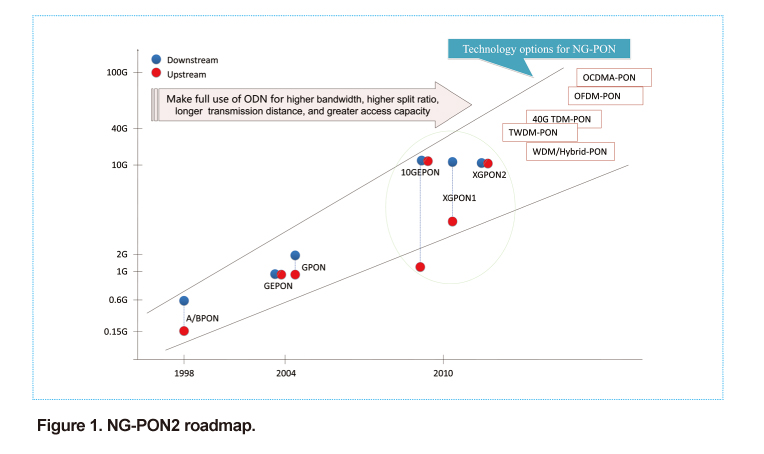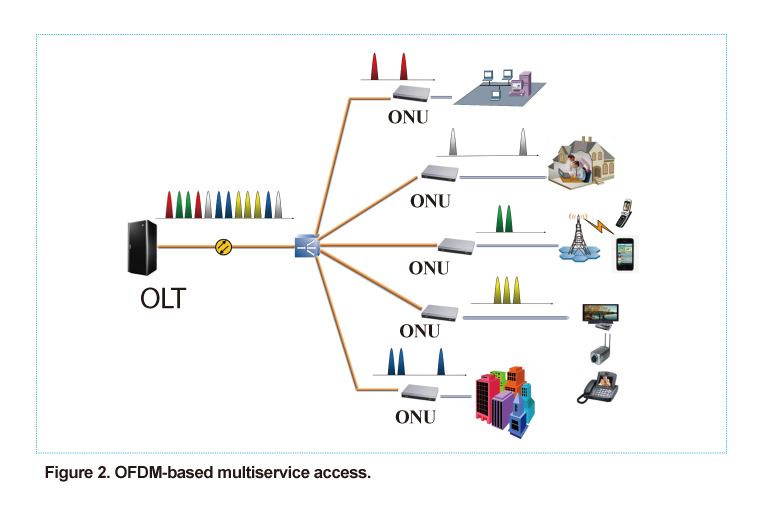A Discussion on OFDM-PON
Innovation in network technologies is driving the growth of IPTV, HDTV, 3DTV, mobile media, and streaming video. To meet the corresponding explosion in bandwidth demand, 40G and 100G optical systems have been commercially deployed at the backbone layer. 400G/1T systems are also being researched. The access layer must be capable of handling increased traffic and supporting many more services. Currently, access networks are passive optical networks (PONs) with a tree structure; in particular, TDM-PON has been widely applied. EPON and GPON are suitable for FTTx networks. The 10G xPON standard and industry chain have matured, and 10G xPON will become a mainstream technology for FTTx networks in the next five years.
NG-PON2, a long-term PON solution, is a hot topic being discussed by ITU-T and FSAN. Most operators expect NG-PON2 to provide higher bandwidth, higher split ratio, longer transmission distance, and greater access capacity while making full use of existing optical distribution networks. Technology options for NG-PON2 include WDM-PON, OFDM-PON, TWDM-PON, and high-speed TDMA-PON.

Orthogonal frequency division multiplexing (OFDM) in optical communications is innovative. OFDM is a multicarrier transmission technique that dynamically allocates high-speed serial bit streams to subcarriers with overlapping spectra to improve spectral efficiency. High-order modulation schemes such as PSK and QAM are used for these subcarriers. This enhances system capacity. OFDM is effective in eliminating inter-symbol interference caused by multipath and chromatic dispersion in transmission links.It increases symbol length and uses cyclic prefixes. OFDM modulation incorporates software defined radio. DSP chips are programmed to implement DFT/IDFT as well as digital-to-analog or analog-to-digital conversion. Most system functions, excluding RF front-end and antenna, are software-implemented. The advantages of using software are flexibility, ease of use, accurate computing, reconfigurability, and efficient digital signal processing.
OFDM can be used as a modulation technique to increase spectral efficiency and channel capacity. It can also eliminate multipath and dispersion effects. Subcarriers can be used to enable OFDMA and to allow flexible bandwidth allocation for multiple subscribers and services. Different subcarriers can be allocated to subscribers or services such as TDM, FTTH, FTTB, mobile station, WiMAX repeater, and WiFi hot spots. These features make OFDM applicable to access networks (Fig. 2).

OFDM has been successfully applied to ADSL, DVB-T, WLAN and WiMAX and is a core transmission technology for next generation wireless systems including 3GPP LTE. OFDM-PON dynamically allocates bandwidth and has superior transmission capability. Cheaper electronic devices are used instead of costly optical devices, and ASIC based DSP and AD/DA also reduce equipment costs. OFDM-PON can be combined with WDM and has therefore become a competitive technology for NG-PON2. Combining OFDM and PON has the following advantages:
Dynamic allocation of subcarriers. Depending on channel environments and application scenarios, OFDM can dynamically allocate the number of bits carried by each subcarrier, the modulation scheme used by each subcarrier, and the transmitting power of each subcarrier. It does this by using a simple FFT algorithm. In OFDM-PON, allocation of each subcarrier occurs in real time according to access distance, subscriber type, and access service. Uncomplicated protocols help optimize the access network.
Converged wireline and wireless access. An optical access network has enormous bandwidth potential and good QoS but lacks mobility and is unable to meet the diverse requirements of different terminals. A wireless access network is more flexible and mobile but has poor QoS. OFDM is a mature technology in wireless communications that has been applied to WiMAX, WiFi and UWB. By using OFDM to carry PON signals, wireline and wireless access can be converged. In other words, OFDM supports access to baseband OFDM, UWB (MB-OFDM), WiMAX or WiFi, and millimeter-wave OFDM signals. This significantly increases the universality of access networks.
Enhanced spectral efficiency. Because of orthogonality between subcarriers, OFDM allows spectral overlap of individual subchannels. OFDM also uses a simple constellation mapping algorithm for high-order modulation schemes such as 16QAM and 8PSK. OFDM in PON makes effective use of spectral resources and improves spectral efficiency. This lays a solid foundation for WDM-PON to be upgraded to DWDM-PON and UDWDM-PON.
Smooth evolution to ultra-long-haul access network. A simple network structure improves the performance of an access network and reduces costs. Converged MAN and PON access has become a hot topic in recent years, and ultra-longhaul access networks (longer than 80km) have been proposed. The primary issue for ultra-longhaul access is reducing the effect of fiber chromatic dispersion. Theoretically, OFDM signals are free from chromatic and polarization-mode dispersion in optical links. Therefore, OFDM-PON can be used to smoothly evolve optical access networks to ultra-longhaul access networks.
Avoiding costly optical devices and using cheaper electronic devices. Integrated optical devices are very costly, and optical modules of 10G or higher can significantly drive up the cost of an access network. OFDM avoids costly optical devices and uses cheaper electronic devices. OFDM leverages the integration and low-cost advantages of high-speed digital signal processors and high-frequency microwave devices to develop access networks and make them more popular.
Work on NG-PON2 is progressing well in FSAN. An NG-PON2 white paper is expected to be released in early 2012. ZTE led research into key techniques for OFDM-PON in China’s “863” program and “tri-network convergence” project. OFDM-PON prototype will be completed by the end of 2013. ZTE has been actively involved in standardization of NG-PON2.